Jun
24
the rainy season
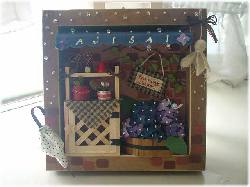 Now we're in the depressing rainy season of June.
Now we're in the depressing rainy season of June.
Though it's fine today, it had been raining a few days in a row until yesterday. It seems that the unpleasant weather will continue some more weeks before summer comes.
As many of you know, the humidity is very high in Japanese summer, let alone the rainy season. It's hot and humid especially recently because warming by the greenhouse effect is, of course also here, influences the heat of our summer. The temperature is clearly higher than that of many years ago. Still summer is far better than winter for me as I can't stand the cold weather.
By the way, the theme of the handcraft frame in the picture above is the rainy season called tsuyu in Japanese. The items express the old fashioned Japanese summer.
If the cherry blossoms are the flowers of April and the azaleas are that of May, the flowers of June are hydrangeas in Japan. Many of purple ones are in the frame. And at the bottom of them, there is a wooden tarai, which means a wash tub. That is also a symbolic item of old fashioned Japan. A wood rack is also there next to the tub. Some gardening tools are on the rack.
Then there are an umbrella and the beads which are rain drops around the frame. And more, see the small doll is pinned with a brown ribbon at the right top of the frame. It's called teru treu bouzu, which is usually made of paper to pray for fine weather. Though it's a small frame, it contains full of funny items, doesn't it?
Anyway, now summer is approaching. I'm looking forward to go to Gion Festival in Kyoto next month. It's hot and humid but there are also a lot of pleasures in summer here. I love it!
Categories:
diary ,
handcrafts
May
5
the golden week
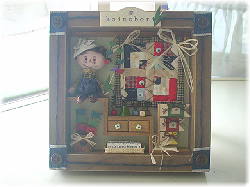 We're in the middle of the golden week. You may know that three national holidays are in a row in the first week of May and there is another national holiday at the end of April in Japan. So, if the timing is good, you can get a week off from work. It's called the golden week.
We're in the middle of the golden week. You may know that three national holidays are in a row in the first week of May and there is another national holiday at the end of April in Japan. So, if the timing is good, you can get a week off from work. It's called the golden week.
May the 5th is traditionally called Tango no sekku and it's originally a festival for boys.
But it's called kodomo no hi means "Children's day" recently. Yet, the traditional custom is still alive. We raise some carp streamers outside to celebrate the day because a carp is regarded as a symbol of courage since it swims upstream against the current. Those carp streamers are koi nobori means "rising carps or carp flags".
We also display special dolls called Mushaningyou which are modeled after the warriors of the Middle Ages. Both of them are for wishing boys to grow up strong. So the day is turned now for wishing all the children (both boys and girls) to grow up healthy and strong.
See the handcraft frame in the picture above. There are some koi nobori shaped items and a boy with kabuto is sitting on a wood shelf. Kabuto is an old-fashioned helmet which was used in the Middle Ages. Shoubu or Japanese irises are also in the frame because the flower is a symbol of Tango no sekku. The word shoubu is also means "win or lose", which is a symbolic word for brave warriors. I think it's a pun.
As you know that the Japanese summer is hot and unbearably humid, this is the best season for us before the rainy season called tsuyu in June and the unpleasant summer.
Categories:
events
,
handcrafts
Apr
6
tole painting
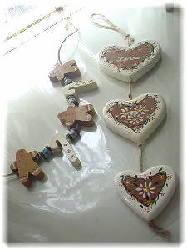 These room accessories in the picture are tole painting. The gingerman necklace is the first one which I made.
These room accessories in the picture are tole painting. The gingerman necklace is the first one which I made.
Handcrafts boom has died down for years here but it was very popular about ten years ago. So there were a lot of fine kits for beginners. Some of them are in the pictures on this page.
Tole painting itself is not so difficult but it takes time to finish. As the bases are mainly plain wood, the first thing before painting is to polish them. That is very laborious because the surface must be smooth enough to use brushes freely. If this first step is rough, it won't go well after that sometimes.
However you can also enjoy the rough appearance intentionally. That depends on what kind of pictures you want to paint on the base. Incidentally cans are used as bases, too.
Plain wood bases
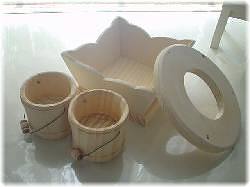
After polishing the bases, undercoat next, painting pictures and give the final coating. Each step must handle with care to finish finely.
The finished works are used not only as ornaments but also as practical items. There are a mini box and a square tray in the following pictures for example. You can use those things to keep small accessories or I put a lace paper in the tray and use it as a cookie tray at tea times. Using handmade items this way brings a daily small happiness from time to time.
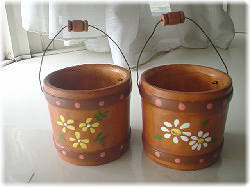
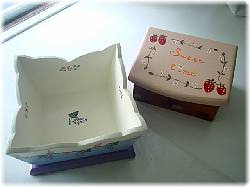
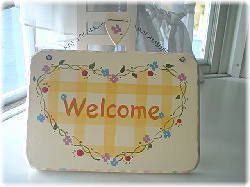
As I like the country taste, I made many items after finishing this first series for beginners. I'll put the pictures of them here in the meantime.
Categories:
handcrafts
Feb
29
Hina-matsuri
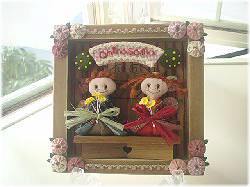 Here's another handcraft frame. This is for March. The theme is Hina-matsuri because we celebrate the day for girls on March 3rd.
Here's another handcraft frame. This is for March. The theme is Hina-matsuri because we celebrate the day for girls on March 3rd.
Hina means dolls which we display to celebrate the day and matsuri means a festival. So Hina-matsuri literally means "Dolls' Festival".
They say that the beginning of this festival goes back to Japanese medieval era called Heian Jidai. So the history is very long and old.
The dolls in my frame are very small and simple but the real hinas are more luxurious and larger. A five-staged decoration is a formal style.
A prince and a princess are on the top stage, three maids on the second stage, five musicians which play Japanese traditional instruments on the third, one minister is on both sides of the fourth stage and three followers are on the fifth. The clothes they wear are in Heian style. The aristocratic people in those days wore more complicated kimono than people in Edo era.
In addition to the dolls, imitations of cars, designed floor lights called bonbori, rhomboid sweets and flowers are displayed with them. So the real five-staged decoration for Hina-matsuri is very gorgeous.
We do the festival mainly for girls to exorcise and to pray for good health. There is another festival called Tango no sekku for boys in May.
Hina-matsuri is also called momo no sekku. Momo means a peach and sekku means a punctuation of a season. Peach blossoms are blooming in March and the season is gradually changing into spring. That is because Hina-matsuri is also called mono no sekku.
Well, now we're almost in March. Spring is approaching.
Categories:
events
,
handcrafts
Feb
05 two handcrafts
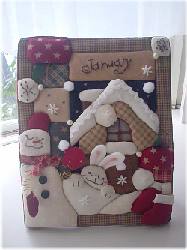
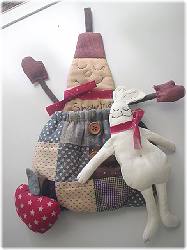
I've just finished making two items. One is a kimekomi frame and
the other is a wall pocket.
These were designed by Atsuko Katou who is a Japanese handcraft artist.
I bought five series of kits through a mail-order system. One series
contains 12 kits, so I have 60 kits which feature the cute little bunny
named NOAH or No-kun in Japanese. The kits express seasonal
themes, and these two are for winter season. You can see the bunny and a
snowman in each picture.
Kimekomi is originally a wood-based handcraft but the basement of
this frame is urethane. The following picture is the base.
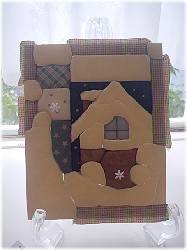
The basement is lined and cut to paste many pieces of cloth and the
picture is completed by pasting those small cut cloths one by one. The
margin of the cloth must be put in the line neatly. And for the last,
add some beads and other parts to finish.
In addition to the lovely bunny, I like the artist's sense of colours
which is warm and full of country taste. I'm now on the way of making
next frame. The theme is St. Valentine's Day. I'll put the photo here
when it is finished. Just wait and see.
Categories:
handcrafts
Jan
16 February is approaching
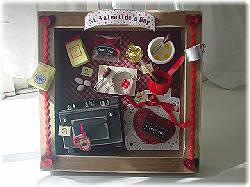 The picture is a doll house like mini frame of which the theme is St.
Valentine's Day. I bought a series of handcraft kits to make this kind
of frame and this is one of them. This one expresses 4 steps to bake a
chocolate cake.
The picture is a doll house like mini frame of which the theme is St.
Valentine's Day. I bought a series of handcraft kits to make this kind
of frame and this is one of them. This one expresses 4 steps to bake a
chocolate cake.
1. materials
2. mix the materials
3. bake a cake in an oven
4. completed
And around the frame, there are a bag of flour, a measuring cup, 4 red
buttons, wavy ribbons on the both sides, and the title board "St.
Valentine' Day" at the top of the frame.
As St. Valentine's day is already commercialized in Japan, many shops
concentrate on selling chocolates for the day after New Year celebration
is over. Many people buy those chocolates not only for their target one
but also friends or familiar people around them. So the custom has
almost become nominal these days. But the special wrappings and window
displays are beautiful and people enjoy and use the day to express their
gratitude each other. It's OK, isn't it? I think the Westerners wonder
why only chocolates are for Valentine's day. In Japan, maybe from the
start, it was a plot or conspiracy (laugh) of chocolate makers to sell
their products. So St. Valentine's day in Japan is much different from
its original custom and style. Anyway now February is approaching.
The following photos are the series of mini frames and each of them
expresses a seasonal theme one by one. I'll up more photos of them in
the mean time.
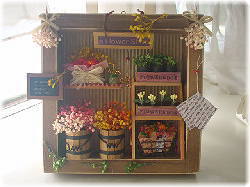 *** April ***
*** April ***
 *** June ***
*** June ***
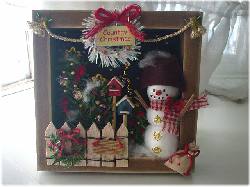 *** December ***
*** December ***
Categories:
events
,
handcrafts
 Now we're in the depressing rainy season of June.
Now we're in the depressing rainy season of June. 
 We're in the middle of the golden week. You may know that three national holidays are in a row in the first week of May and there is another national holiday at the end of April in Japan. So, if the timing is good, you can get a week off from work. It's called the golden week.
We're in the middle of the golden week. You may know that three national holidays are in a row in the first week of May and there is another national holiday at the end of April in Japan. So, if the timing is good, you can get a week off from work. It's called the golden week.  These room accessories in the picture are tole painting. The gingerman necklace is the first one which I made.
These room accessories in the picture are tole painting. The gingerman necklace is the first one which I made.




 Here's another handcraft frame. This is for March. The theme is Hina-matsuri because we celebrate the day for girls on March 3rd.
Here's another handcraft frame. This is for March. The theme is Hina-matsuri because we celebrate the day for girls on March 3rd. 


 The picture is a doll house like mini frame of which the theme is St.
Valentine's Day. I bought a series of handcraft kits to make this kind
of frame and this is one of them. This one expresses 4 steps to bake a
chocolate cake.
The picture is a doll house like mini frame of which the theme is St.
Valentine's Day. I bought a series of handcraft kits to make this kind
of frame and this is one of them. This one expresses 4 steps to bake a
chocolate cake.
 *** April ***
*** April ***
 *** December ***
*** December ***